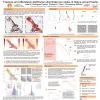Poster #152, Fault and Rupture Mechanics (FARM)
Numerical simulations of dynamic earthquake rupture with different failure laws
Poster Image:

Poster Presentation
2020 SCEC Annual Meeting, Poster #152, SCEC Contribution #10320 VIEW PDF
mbination of several of them), depending on the context of the earthquake (tectonic or induced), observation scale, and specifics of the problem.
To compare the implications of different failure laws, we test them in simplified 1D spring-slider models to determine the characteristics of the resulting earthquake cycle. To study rupture nucleation and propagation in more detail we perform dynamic finite element simulations, applying different failure laws along the fault: slip-weakening friction, double slip-weakening friction, rate-and-state friction, exponential and trapezoidal cohesive zone, etc., and compare the observables including rupture velocity, traction, slip, and slip rate distributions along the fault throughout the simulation. We obtain very similar results for different failure laws in both approaches, provided we set the same fracture energy and only consider planar ruptures. There are minor differences in slip and stress distributions resulting from the different shapes of the failure curves. However, it is challenging to detect them in the simplified modeling results, suggesting that the failure laws studied will be almost indistinguishable for the case of real seismic data. Distinguishing among which failure laws are applicable seems to require independent constraints on the friction law parameters, e.g., from laboratory experiments.
SHOW MORE
To compare the implications of different failure laws, we test them in simplified 1D spring-slider models to determine the characteristics of the resulting earthquake cycle. To study rupture nucleation and propagation in more detail we perform dynamic finite element simulations, applying different failure laws along the fault: slip-weakening friction, double slip-weakening friction, rate-and-state friction, exponential and trapezoidal cohesive zone, etc., and compare the observables including rupture velocity, traction, slip, and slip rate distributions along the fault throughout the simulation. We obtain very similar results for different failure laws in both approaches, provided we set the same fracture energy and only consider planar ruptures. There are minor differences in slip and stress distributions resulting from the different shapes of the failure curves. However, it is challenging to detect them in the simplified modeling results, suggesting that the failure laws studied will be almost indistinguishable for the case of real seismic data. Distinguishing among which failure laws are applicable seems to require independent constraints on the friction law parameters, e.g., from laboratory experiments.
SHOW MORE
























































